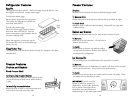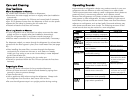
34
CCaarree aanndd CClleeaanniinngg
UUppoonn YYoouurr RReettuurrnn
AAfftteerr aa SShhoorrtt VVaaccaattiioonn oorr AAbbsseennccee::
For models with automatic ice makers or dispensers:
• Reconnect the water supply and turn on supply valve (see Installation
Instructions).
• Monitor water connection for 24 hours and correct leaks if necessary.
• Run 10-15 glasses of water from the dispenser to flush out the system.
• Restart the ice maker by lowering the ice maker arm.
• Discard at least the first three ice harvests.
AAfftteerr aa LLoonngg VVaaccaattiioonn oorr AAbbsseennccee::
• If your refrigerator has an automatic ice maker, reconnect the water
supply and turn on supply valve (see Installation Instructions).
• Plug the refrigerator back in and reset controls (see page 5).
• Monitor water connection for 24 hours and correct leaks, if necessary.
For dispenser models, run water through the dispenser for at least three
minutes with the filter bypass in place, then install water filter (see page
20).
• After installing the water filter, run water through the dispenser
continuously for at least two minutes, or until water runs steady.
Initially you may notice a one to two minute delay in water dispersal
as the internal tanks fills.
• Restart the ice maker by lowering the ice maker arm.
• Discard ice produced within the first 12 hours (at least the first three
harvests).
PPrreeppaarriinngg ttoo MMoovvee
• Follow the above instructions for long vacations/absences.
• Secure all loose items such as shelves and drawers by taping them
securely in place to prevent damage.
• Tape the doors shut.
• Use an appliance dolly when moving the refrigerator. Always truck
the refrigerator from its side or back never from its front.
• Be sure the refrigerator stays in an upright position during moving.
35
OOppeerraattiinngg SSoouunnddss
Improvements in refrigeration design may produce sounds in your new
refrigerator that are different or were not present in an older model.
These improvements were made to create a refrigerator that is better at
preserving food, is more energy efficient, and is quieter overall.
Because new refrigerators run quieter, sounds may be detected that
were present in older refrigerators, but were masked by higher sound
levels. Many of these sounds are normal. Please note that the surfaces
adjacent to a refrigerator, such as hard walls, floors and cabinetry may
make these sounds seem even louder. The following are some of the
normal sounds that may be noticed in a new refrigerator.
SSOOUUNNDD
CClliicckkiinngg
AAiirr rruusshhiinngg oorr
wwhhiirrrriinngg
GGuurrgglliinngg oorr
bbooiilliinngg ssoouunndd
TThhuummppiinngg
VViibbrraattiinngg nnooiissee
BBuuzzzziinngg
HHuummmmiinngg
HH
iissssiinngg oorr
ppooppppiinngg
PPOOSSSSIIBBLLEE CCAAUUSSEE
• Freezer control clicks when
starting or stopping compressor.
• Freezer fan and condenser fan
make this noise while operating.
• Evaporator and heat exchanger
refrigerant makes this noise when
flowing.
• Ice cubes from ice maker drop
into ice bucket.
• Dispenser ice chute closing
• Compressor makes a pulsating
sound while running.
• Refrigerator is not level.
• Ice maker water valve hookup
buzzes when ice maker fills with
water.
• Ice maker is in the ‘on’ position
without water connection.
• Compressor can make a high-
pitched hum while operating.
• Defrost heater hisses,
sizzles or
pops when operational.
SSOOLLUUTTIIOONN
• Normal operation
• Normal operation
• Normal operation
• Normal operation
• Normal operation
• Normal operation
• See Installation
Instructions for details
on how to level your
refrigerator.
• Normal operation
• Stop sound by raising
ice maker arm to OFF
position see page 15.
• Normal operation
• Normal operati
on


















